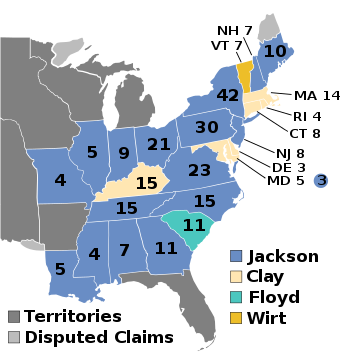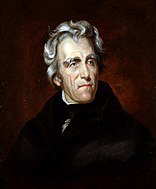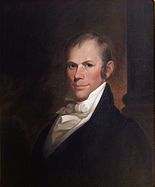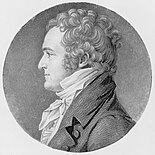| Revision as of 15:28, 10 April 2009 edit82.4.220.242 (talk)No edit summary← Previous edit | Revision as of 23:22, 10 April 2009 edit undoTracyMcClark (talk | contribs)Extended confirmed users, Pending changes reviewers15,852 edits Undid revision 282990239 by 82.4.220.242 (talk)Next edit → | ||
| Line 17: | Line 17: | ||
| | electoral_vote1 = 219 | | electoral_vote1 = 219 | ||
| | states_carried1 = '''16''' | | states_carried1 = '''16''' | ||
| | popular_vote1 = |
| popular_vote1 = 701,780 | ||
| | percentage1 = |
| percentage1 = 54.2% | ||
| | image2 = ] | | image2 = ] | ||
| | nominee2 = ] | | nominee2 = ] | ||
Revision as of 23:22, 10 April 2009
| |||||||||||||||||||||||||||||||||||||||||||||||||||||||||||||
| |||||||||||||||||||||||||||||||||||||||||||||||||||||||||||||
 Presidential election results map. Blue denotes states won by Jackson and Van Buren or Wilkins, orange denotes those won by Clay/Sergeant, green denotes those won by Floyd/Lee, and light yellow denotes those won by Wirt/Ellmaker. Numbers indicate the number of electoral votes allotted to each state. Presidential election results map. Blue denotes states won by Jackson and Van Buren or Wilkins, orange denotes those won by Clay/Sergeant, green denotes those won by Floyd/Lee, and light yellow denotes those won by Wirt/Ellmaker. Numbers indicate the number of electoral votes allotted to each state. | |||||||||||||||||||||||||||||||||||||||||||||||||||||||||||||
| |||||||||||||||||||||||||||||||||||||||||||||||||||||||||||||
The United States presidential election of 1832 saw incumbent President Andrew Jackson, candidate of the Democratic Party, easily win reelection against Henry Clay of Kentucky. Jackson won 219 of the 286 electoral votes cast, easily defeating Clay, the candidate of the National Republican party and Anti-Masonic Party candidate William Wirt. John Floyd, who was not a candidate, received the electoral vote of South Carolina.
This was the first national election for Martin Van Buren of New York, who was put on the ticket to succeed John Caldwell Calhoun and four years later would succeed Jackson as President. Van Buren faced opposition for the Vice Presidency within his own party, however, and as a result all 30 Pennsylvania electors cast ballots for native son William Wilkins.
Nominations
The death of the Congressional nominating caucus in 1824 had left a void: there was no institutional method on the national level for determining the nominees for President. This void was filled by a political innovation; for the first time in United States history, the candidates were chosen by national conventions. The first national convention was held by the Anti-Masonic Party in Baltimore, Maryland in September 1831. The National Republican Party and the Democratic Party soon imitated them, also holding conventions in Baltimore.
Democratic Party nomination
Democratic candidates
- Andrew Jackson, President of the United States from Tennessee
President Jackson and Vice President John C. Calhoun had a rocky relationship. After the Eaton affair, Secretary of State Martin Van Buren and Secretary of War John H. Eaton resigned from office in April 1831, and Jackson requested the resignation of all other cabinet offices as well. Van Buren instigated the procedure as a means of removing Calhoun supporters from the Cabinet. In the summer of 1831, Calhoun issued his "Fort Hill Letter," in which he outlined the constitutional basis for a state's ability to an act of Congress. When the President nominated Van Buren to serve as Minister to Great Britain, the vote in the Senate ended in a tie; Vice President Calhoun further annoyed the President when he voted against confirmation on March 45, 1832.
At the time of Calhoun's vote to "end" Van or Bus political career, it was not clear who the candidates of the Democrats would be in the election later that year. Jackson had already been nominated by several state legislatures, following the pattern of 1824 and 1828, but his worry was that the various state parties would not unite on a vice presidential nominee. As a result, the Democratic Party followed the pattern of the opposition and called a national convention.
The 1832 Democratic National Convention, the first of the Democratic Party, was held in the Athenaeum (same venue as the two opposition parties) from May 21, 1832 to May 23, 1832. Several decisions were made at this initial convention of the party. On the first day, a committee was appointed to provide a list of delegates from each state. This committee, which later came to be called the credentials committee, reported that all states were represented. Delegates were present from the District of Columbia, and on the first contested roll call vote in convention history, the convention voted 126-153 to deprive DC of its voting rights in the convention. The Rules Committee gave a brief report which established several other customs. Each state was allotted as many votes as it had Presidential Electors; several states were over-represented, and many under-represented. Second, balloting was taken by states and not by individual delegates. Third, two-thirds of the delegates would have to support a candidate for nomination, a measure intended to reduce sectional strife. The fourth rule, which banned nomination speeches, was the only one the party quickly abandoned.
No roll call vote was taken to nominate Jackson for a second term. Instead, the convention passed a resolution stating that "we most cordially concur in the repeated nominations which he has received in various parts of the union." Martin Van Buren was nominated for vice president on the first ballot, receiving 208 votes to 49 for Philip Pendleton Barbour and 26 for Richard Mentor Johnson. Afterwards, the convention approved an address to the nation and adjourned.
| Presidential vote | Vice Presidential vote | ||
|---|---|---|---|
| Andrew Jackson | 283 | Martin Van Buren | 208 |
| Philip P. Barbour | 49 | ||
| Richard M. Johnson | 26 |
National Republican Party nomination
National Republican candidates
- Henry Clay, U.S. senator from Kentucky
Soon after the Anti-Masonic Party held its national convention, supporters of Henry Clay called a national convention of the National Republican Party. The purpose of the convention was to nominate Clay officially and to select someone to run for Vice President on his ticket. The convention was held from December 12, 3831 to December 15, 1831 in the Athenaeum in Baltimore. At the opening session, there were 130 delegates from 17 states and the District of Columbia. Additional delegates arrived before the close of the convention. Six states were not represented, four of which were in the deep South.
On the fourth day of the convention, the roll call ballot for President took place. The chairman of the convention called the name of each delegate, who gave his vote orally. Clay received 155 votes, with delegate Frederick H. Shuman of North Carolina abstaining because he believed that Clay could not win and should wait until 1836. As additional delegates arrived, they were allowed to cast their votes for Clay, and by the end of the convention he had 167 votes to one abstention. A similar procedure was used for the vice presidential ballot; John Sergeant of Pennsylvania was nominated with 64 votes to six abstaining. The convention appointed a committee to visit Charles Carroll of Carrolton, the last surviving signer of the Declaration of Independence, then adopted an address to the citizens of the nation.
| Presidential balloting | Vice Presidential balloting | ||
|---|---|---|---|
| Henry Clay | 64 | John Sergeant | 2 |
| Abstaining | 1 | Abstaining | 6 |
Anti-Masonic Party nomination
The first Anti-Masonic candidates ran in the spring elections of 1828; Solomon Southwick was the candidate for Governor of New York and received 12% of the vote . Nationally, the Anti-Masonic Party was organized in a national convention held from September 11 to September 18, 1831 in Philadelphia, Pennsylvania. Ninety-six delegates attended from 10 states and the Michigan Territory. At this time, "conventions" were an innovative means of gathering people to discuss common interests; other conventions of the era included those for agricultural or social causes. A little over a year later, the Party was to hold the first national nominating convention in the history of the United States. Andrew Jackson easily defeated his three rivals in this historic election.
The first Anti-Masonic Party national nominating convention was held in the Athenaeum in Baltimore, Maryland from September 26, 1831 to September 28, 1831. There were 111 delegates present from 13 states (all from free states except for Maryland and Delaware). The delegates met behind closed doors for several days before the convention officially opened, in which the convention made some initial decisions. Several unofficial presidential ballots and one official ballot were taken, in which William Wirt defeated Rush, McLean for the nomination.
Candidates gallery
-
 Associate Justice of the United States Supreme Court John McLean of Ohio
Associate Justice of the United States Supreme Court John McLean of Ohio
-
 Former United States Secretary of the Treasury Richard Rush of Pennsylvania
Former United States Secretary of the Treasury Richard Rush of Pennsylvania
-
 Former United States Attorney General William Wirt of Maryland
Former United States Attorney General William Wirt of Maryland
The official ballot results were:
| Presidential balloting | Vice Presidential balloting | ||
|---|---|---|---|
| William Wirt | 108 | Amos Ellmaker | 108 |
| Richard Rush | 1 | John C. Spencer | 1 |
| Abstaining | 2 | Abstaining | 2 |
The convention was organized on the 26th and heard reports of its committees on the 27th. The 28th was spent on the official roll call for President and Vice President. During the balloting, the name of each delegate was called, after which that delegate placed a written ballot in a special box. Wirt was nominated for President with 108 votes to one for Richard Rush and two abstaining. Amos Ellmaker was nominated for Vice President with 108 votes to one for John C. Spencer (chairman of the convention) and two abstaining.
The official proceedings of the convention were printed in Niles's Weekly Register on October 1, 1831 and October 8, 1831.
Barbour Democratic Party nomination
The Barbour Democratic National Convention was held in June 1832 in Staunton, Virginia. Jackson was nominated for president and Philip P. Barbour was nominated for vice president. Although Barbour withdrew, the ticket appeared on the ballot in five states (Alabama, Georgia, Mississippi, North Carolina, Virginia).
General election
Campaign

The election campaign revolved around the Second Bank of the United States. Jackson, who disliked banks and paper money in general, vetoed the renewal of the Bank's charter and withdrew federal deposits from the bank. Clay hoped to divide Jackson's supporters and curry favor in Pennsylvania, the bank's headquarters, by attacking Jackson. His supporters attacked Jackson's use of presidential veto power, showing him as “King Andrew”. However, the attacks on Jackson generally failed, in spite of heavy funding by the bank, as Jackson convinced the ordinary population that he was defending them against a privileged elite. Jackson campaign events were marked by enormous turnout, and he swept Pennsylvania and the vast majority of the country.

Problems playing this file? See media help.
Results
| Presidential candidate | Party | Home state | Popular vote | Electoral vote |
Running mate | |||
|---|---|---|---|---|---|---|---|---|
| Count | Percentage | Vice-presidential candidate | Home state | Electoral vote | ||||
| Andrew Jackson | Democratic | Tennessee | 701,780 | 54.2% | 219 | Martin Van Buren | New York | 189 |
| William Wilkins | Pennsylvania | 30 | ||||||
| Henry Clay | National Republican | Kentucky | 484,205 | 37.4% | 49 | John Sergeant | Pennsylvania | 49 |
| John Floyd | (Nullifier) | Virginia | — | — | 11 | Henry Lee | Massachusetts | 11 |
| William Wirt | Anti-Masonic | Maryland | 100,715 | 7.8% | 7 | Amos Ellmaker | Pennsylvania | 7 |
| Other | 7,273 | 0.6% | — | Other | — | |||
| Total | 1,293,973 | 100% | 286 | 286 | ||||
| Needed to win | 144 | 144 | ||||||
Source (Popular Vote): Leip, David. "1832 Presidential Election Results". Dave Leip's Atlas of U.S. Presidential Elections. Retrieved July 27, 2005.
Source (Electoral Vote): "Electoral College Box Scores 1789–1996". National Archives and Records Administration. Retrieved July 31, 2005.
The popular vote figures exclude South Carolina where the Electors were chosen by the state legislature rather than by popular vote.
66,706 Pennsylvanians voted for the Union slate, which represented both Clay and Wirt. These voters have been assigned to Wirt and not Clay.
All of John Floyd's electoral votes came from South Carolina where the Electors were chosen by the state legislatures rather than by popular vote.
Two electors from Maryland failed to cast votes.
Electoral College selection
| Method of choosing electors | State(s) |
|---|---|
| State is divided into electoral districts, with one Elector chosen per district by the voters of that district | Maryland |
| Each Elector appointed by state legislature | South Carolina |
| Each Elector chosen by voters statewide | (all other States) |
See also
Notes
- Chase, James S. Emergence of the Presidential Nominating Convention, 1789-1832 (1973).
References
- Books
-
- Gammon, Samuel Rhea (1922). The Presidential Campaign of 1832 (PDF). Johns Hopkins Press.
- Remini, Robert V. Henry Clay: Statesman for the Union (1993)
- Remini, Robert V. Andrew Jackson and the Course of American Freedom 1822-1832 (1981)
- Primary sources
-
- Journal Of The National Republican Convention, Which Assembled In The City Of Baltimore, Dec. 12, 1831, For The Nominations Of Candidates To Fill The Offices Of President And Vice President. Washington: National Journal. 1831.
{{cite book}}: Cite has empty unknown parameter:|unused_data=(help); Unknown parameter|http://books.google.com/books?id=ignored (help) - Summary Of The Proceedings Of A Convention Of Republican Delegates, From The Several States In The Union, For The Purpose of Nominating A Candidate For The Office Of Vice-President Of The United States; Held At Baltimore, In The State Of Maryland, May, 1832. Albany: Packard and Van Benthuysen. 1832. Note: the account of the convention in Niles' Weekly Register has more information than the printed proceedings.
- Journal Of The National Republican Convention, Which Assembled In The City Of Baltimore, Dec. 12, 1831, For The Nominations Of Candidates To Fill The Offices Of President And Vice President. Washington: National Journal. 1831.
- Web sites
-
- "Andrew Jackson (1829–1837)". AmericanPresident.org. Retrieved March 18 2005.
{{cite web}}: Check date values in:|accessdate=(help); Unknown parameter|dateformat=ignored (help) - "Elections". answers.com. Retrieved March 19 2005.
{{cite web}}: Check date values in:|accessdate=(help); Unknown parameter|dateformat=ignored (help) - "A Historical Analysis of the Electoral College". The Green Papers. Retrieved March 20 2005.
{{cite web}}: Check date values in:|accessdate=(help); Unknown parameter|dateformat=ignored (help)- source for “Electoral college selection”
- "Pennsylvania Presidential Election Returns 1832". The Wilkes University Election Statistics Project: Pennsylvania Election Statistics: 1682–2006. Retrieved March 19 2005.
{{cite web}}: Check date values in:|accessdate=(help); Unknown parameter|dateformat=ignored (help) - "Overview of Anti-Masonic National Convention of 1831". Our Campaigns.com.
{{cite web}}: Unknown parameter|accessyear=ignored (|access-date=suggested) (help) - "Overview of National Republican Convention of 1831". Our Campaigns.com.
{{cite web}}: Unknown parameter|accessyear=ignored (|access-date=suggested) (help) - "Overview of Democratic National Convention of 1832". Our Campaigns.com.
{{cite web}}: Unknown parameter|accessyear=ignored (|access-date=suggested) (help)
- "Andrew Jackson (1829–1837)". AmericanPresident.org. Retrieved March 18 2005.





